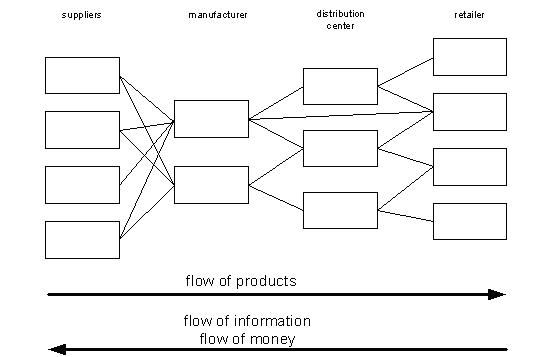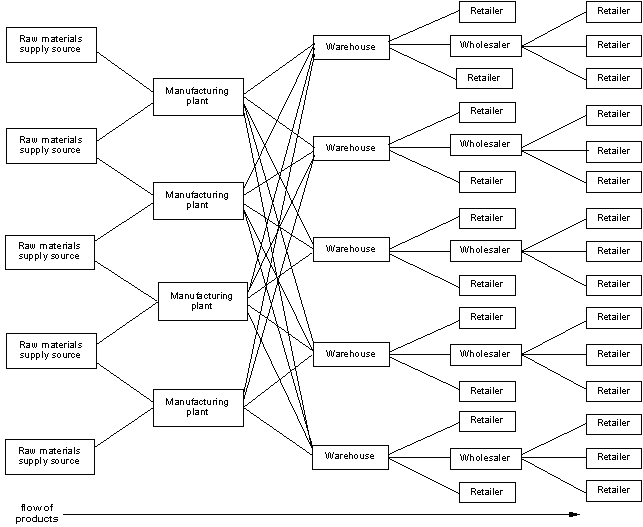There are multiple definitions found for supply chains in literature. According to the Supply Chain Council (http://www.supply-chain.org), a definition of a supply chain is: "The supply chain – a term now commonly used internationally – encompasses every effort involved in producing and delivering a final product or service, from the supplier's supplier to the customer's customer". The series of companies (actors) that interact for this producing and delivering is what will be called supply chain here. The actors are connected through the flow of products, the flow of information and the flow of money. Another definition is given by D. Simchi-Levi, E. Simchi-Levi and Kaminsky, who state that supply chains are flexible, dynamic and complex networks of organizations [Simchi-Levi et al., 2003].
The reason for the existence of supply chains is that there are very few companies that can produce end products for end-customers from raw materials on their own, without the assistance of other organizations. The company that produces the raw material is often not the same company that sells the end products to the end-customer. In order to provide end products to the end-customers, a network of actors is involved in activities (as purchasing, transforming and distribution) to produce products and/or services (Stevens, 1989; Lee & Billington, 1995; Swaminathan, Smith & Sadeh, 1996; Cooper et al., 1997). All of these actors add value to the end product (Lummus, 1999). The series of companies that interact to produce end products, and to contribute to the value of end products, is what will be called a supply chain in the context of the games on this site.

From this description, the image of a supply chain in general is provided. The actors are connected through the flow of products, flow of information and the flow of money. In the figure above, a general supply chain model is illustrated. The blocks represent the organizations/companies that handle the products and add value. The choice for the term supply chain is unfortunately because it leads to confusion. "Chains" evoke linear, unchanging, and powerless images. "Supply" feels pushy and reeks of mass production rather than mass customization. Better names like "demand network" or "customer driven webs" have been proposed. Yet, the name "supply chain" seems to have stuck (Johnson & Pyke, 2000). Strictly speaking, the supply chain is a network of multiple businesses and relationships (Lambert, Cooper & Pagh, 1998). The picture below gives a more accurate description of a demand network (Coyle et al., 1996).

The term supply chain management is relatively new in literature, appearing first in 1982 by Oliver and Webber. Supply chain management is viewed by many as a highly novel management concept, but comparison with earlier work reveals similarities. The fundamental assumptions, on which supply chain management rests, are significantly older (Cooper et al., 1997).
Supply chain systems were regarded as channels of distribution. From this perspective the focus of channel management was on making each firm in the distribution channel more efficient and productive. Each firm operated on its own, seeking to make the highest profits with little attention paid to its channel counterparts (Lancioni, 2000).
More recently, many manufacturers and retailers have embraced the concept of supply chain management to improve efficiency across the value chain (Tan, 2001). The original use of the term supply chain management emphasized a reduction in inventory both within and across firms, which the logistics manager was confronted with, but that initial perspective has been broadening (Keith & Webber, 1992).
Consequently, the competition is no longer between firms but between supply chains. The goals of the entire supply chain become the common objective of each firm. Cost and service improvements that were not achievable by individual firms, will now be attained by cooperating companies (Lancioni, 2000).
Literature
Boyson, S., Corsi, T., Dresner, M., & Harrington, L., Logistics and the Extended Enterprise, John Wiley & Sons, Inc. New York, 1999
Cooper, M., Lambert, D., & Pagh, J., Supply chain management: More than just a name for logistics, The International Journal of Logistics Management, vol. 8, no. 1, 1997
Coyle, J., Bardi, E., & Langley, J., The Management of Business Logistics, Sixth edition, West Publishing Company, Minneapolis, 1996
Johnson, E., & Pyke, D., Supply Chain Management: Innovations for Education, Production and Operations Management Society, Miami, Florida, USA, 2000
Keith, O., & Webber, M., Supply-Chain Management: Logistics Catches Up with Strategy, The Strategic Issues, Chapman and Hall, London, 1992
Lambert, D., Cooper, M. & Pagh, J., Supply Chain Management; implementation issues and research opportunities, The International Journal of Logistics Management, vol. 9, no. 2, 1998
Lancioni, F., New developments in supply chain management for the millennium, Industrial Marketing Management, vol. 29, no. 1, 2000
Lee, H., & Billington, C., The evolution of Supply-Chain-Management Models and Practice at Hewlett-Packard, Interfaces vol. 25, no. 5, 1995
Lummus, R., Defining Supply Chain Management: A Historical perspective and practical guidelines, Industrial Management and Data Systems, vol. 99, no.1, 1999
Oliver, R., & Webber, M., Supply Chain Management: Logistics catches up with Strategy, in: Booz, Allen & Hamilton: Outlook 1982
Simchi-Levi, D., Kaminsky, P., & Simchi-Levi, E., Designing and Managing the Supply Chain; Concepts, Strategies, and Case Studies, Irwin/McGraw-Hill, 1999
Stevens, G., Integrating the supply chain, International Journal of Physical Distribution and Logistics Management, vol. 19, no. 8, 1989
Swaminathan, J., Smith, S. & Sadeh. N., A multi agent framework for modeling supply chain dynamics. Technical Report, The Robotics Institute, Carnegie Mellon, 1996
Tan, K., A framework of supply chain management literature, European Journal of Purchasing and Supply Management, vol. 9, no. 1, 2001


